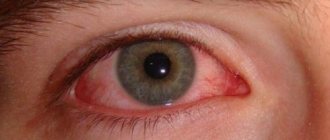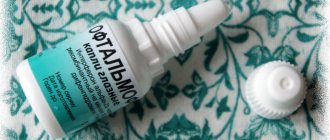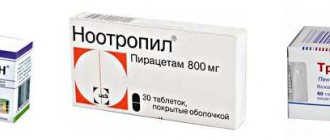Pharmacodynamics and pharmacokinetics
Pharmacodynamics
Chemically, levofloxacin is the L-isomer of the racemate of the drug Ofloxacin . the L-isomer of Ofloxacin that has an antibacterial effect .
An antibacterial agent from the pharmacological group of fluoroquinolones , inhibits the activity of type 2 topoisomerase DNA gyrase and topoisomerase of bacterial cells. The action in the cells of gram-negative microorganisms is directed mainly at DNA gyrase , and in gram-positive microorganisms - at topoisomerase of the fourth type.
Active against gram-negative aerobes : Haemophilus influenzae, Branchamella cataralis, Neisseria gonorrhoeae and Pseudomonas aeruginosa; gram-positive aerobes : Streptococcus pneumoniae, Streptococcus pyogenes, Staphyloccocus aureus.
Pharmacokinetics
After use, levofloxacin is well fixed in the tear film. Typically, the average concentration in the blood 60 minutes after use ranges from 0.86-2.05 ng/ml.
The highest concentration of levofloxacin in the blood is recorded on the fourth day after two days of using the drug eight times a day.
Oftaquix 5 mg/ml 0.5 ml No. 10 eye drops, tube-drop.
APPROVED by the Order of the Chairman of the Committee for Control of Medical and Pharmaceutical Activities of the Ministry of Health of the Republic of Kazakhstan From "__" ____20____ No. INSTRUCTIONS for the medical use of the drug OFTAQUIX® Trade name Oftaquix® International nonproprietary name Levofloxacin Dosage form Eye drops 5 mg/ml Composition 1 ml of solution contains the active substance - levofloxacin hemihydrate - 5.12 mg (equivalent to 5.0 mg of levofloxacin); excipients: sodium chloride, hydrochloric acid, sodium hydroxide, water for injection. Description Transparent solution from light yellow to light greenish-yellow color without mechanical inclusions. Pharmacotherapeutic group Drugs for the treatment of eye diseases. Antimicrobial drugs. Levofloxacin. ATC code S01AX19 Pharmacological properties Pharmacokinetics After instillation into the eye, levofloxacin is well preserved in the tear film. The average concentration of levofloxacin in the tear film 4 and 6 hours after topical application is 17.0 μg/ml and 6.6 μg/ml, respectively. The mean levofloxacin concentration of Oftaquix® eye drops in aqueous humor is approximately twice as high as the mean ofloxacin concentration (1139.9 ± 717.1 ng/ml and 621.7 ± 368.7 ng/ml, respectively). The average concentration of levofloxacin in blood plasma 1 hour after use is from 0.86 ng/ml on the 1st day to 2.05 ng/ml on the 15th day. The maximum concentration of levofloxacin in plasma, equal to 2.25 ng/ml, was detected on the 4th day after two days of using the drug every 2 hours up to 8 times a day. The maximum concentration of levofloxacin increased from 0.94 ng/ml on day 1 to 2.15 ng/ml on day 15, which is 1000 times lower than its concentration after oral administration of standard doses of levofloxacin. Bioabsorption is high - from 60 to 100%. Pharmacodynamics Oftaquix®, the active ingredient of which is levofloxacin, is a levorotatory isomer of the racemic substance ofloxacin. The antibacterial activity of ofloxacin is predominantly due to the levorotatory isomer. Mechanism of action As an antibacterial drug of the fluoroquinolone class, levofloxacin selectively inhibits bacterial topoisomerase type II - DNA gyrase and topoisomerase IV. The preferred targets of levofloxacin in gram-negative bacteria are DNA gyrase, and in gram-positive bacteria topoisomerase IV. Effective against the following microorganisms: Aerobic gram-positive: Staphylococcus aureus (MSSA)*, Staphylococcus pneumoniae, Staphylococcus pyogenes, Viridans group streptococci Aerobic gram-negative: Escherichia coli, Branhamella (Moraxella) catarrhalis, Haemophilus influenzae, Pseudomonas aeruginosa (local cultures) Other microorganisms Chlamydia trachomatis (treatment of patients with chlamydial conjunctivitis requires concomitant systemic antimicrobial therapy) Species for which acquired resistance may be a problem Aerobic gram-positive microorganisms: Staphylococcus aureus (MRSA)**, Staphylococcus epidermidis Aerobic gram-negative microorganisms: Pseudomonas aeruginosa (hospital strains) * MSSA = methicillin- sensitive strains of Staphylococcus aureus ** MRSA = methicillin-resistant strains of Staphylococcus aureus Indications for use - treatment of superficial bacterial infections - prevention of complications after surgical and laser operations on the eye Method of administration and dosage Locally - 1-2 drops in one or both affected eyes every 2 hours up to 8 times a day for the first 2 days, then 4 times a day for the next 3-5 days. Usually the duration of treatment is 5 days. In some cases, it is possible to increase the course of treatment to 2 weeks. When using other ophthalmic agents simultaneously, the interval between instillations should be at least 15 minutes. To avoid contamination of the solution, the tip of the dropper should not touch the eyelids or tissues around the eye. The contents of one dropper tube are sufficient for instillation into both eyes. Side effects Side effects may occur in approximately 10% of patients. Side effects are usually mild to moderate, transient, and usually limited to ophthalmic symptoms. Common (³1/100 <1/10) - burning sensation in the eyes - decreased visual acuity - appearance of mucus in the form of strands Rare (³1/1,000 <1/100) - blepharitis, chemosis, conjunctival papillary reaction, eyelid edema, discomfort, itching and eye pain, conjunctival hyperemia, conjunctival follicles, dry eyes, eyelid erythema, photophobia - headache - rhinitis Very rare (³1/10,000, <1/1,000) - extra-ocular allergic reactions, including skin rash Extremely rare (< 1 /10,000), (including individual reports) - anaphylaxis - laryngeal edema Contraindications - hypersensitivity to the active substance - levofloxacin, other quinolones or any excipient - children under 1 year of age Drug interactions Not established Special instructions Oftaquix® eye drops, 5 mg/ ml cannot be administered subconjunctivally. Eye drops should not be instilled directly into the anterior chamber of the eye. Fluoroquinolones for systemic use can cause allergic reactions even after a single use. If an allergic reaction to levofloxacin occurs, you should stop using eye drops. As with all antimicrobial agents, long-term use of Oftaquix® may lead to the growth of resistant microorganisms, including fungi. If infectious manifestations worsen or clinical improvement is not observed after a certain period, it is necessary to stop using the drug and prescribe alternative therapy. Patients who have symptoms of a superficial bacterial eye infection should not wear contact lenses. The safety and effectiveness of the drug in the treatment of corneal ulcers and neonatal gonococcal conjunctivitis have not been studied. Use in the elderly: No dosage change is required. Pregnancy and lactation Oftaquix® eye drops, 5 mg/ml can be used during pregnancy and breastfeeding if the potential benefit to the mother outweighs the possible risk to the infant and fetus. Features of the effect of the drug on the ability to drive a vehicle or potentially dangerous machinery In case of any transient visual impairment, the patient should be advised to wait until vision returns to normal and only then drive a car or operate mechanical equipment. Overdose The total amount of levofloxacin contained in one dropper tube of eye drops is too small to cause toxic reactions after accidental ingestion. After topical application of an excess dose of Oftaquix® eye drops, 5 mg/ml, the eyes can be rinsed with clean water at room temperature. Release form and packaging 0.5 ml of solution in a disposable polyethylene dropper tube with a screw cap. 10 dropper tubes are placed in an aluminum foil bag. 1 package, along with instructions for medical use in the state and Russian languages, is placed in a cardboard box. Storage conditions Store at a temperature not exceeding 25°C. Keep out of the reach of children! Shelf life: 2 years After first opening the package with tube droppers, use it within 3 months. Do not use after the expiration date stated on the package. Conditions for dispensing from pharmacies By prescription Manufacturer JSC Santen, Finland, Tampere, 33720 Niittyhaankatu, 20 under license from Daichi Sankyo Co. Ltd., Japan Name and country of the owner of the registration certificate Santen JSC, Finland Address of the organization that accepts claims from consumers regarding product (product) quality in the territory of the Republic of Kazakhstan: Representative office of Santen JSC in Kazakhstan Almaty, st. Zheltoksan, 129/65 sq. 56 Phone number – 250-39-17 Fax number – 250-39-17 Email address
Side effects
- most often occur: a burning sensation in the eye area, decreased visual acuity, identification of mucous strands;
- less frequently appear: blepharitis , growths in the form of papillae on the conjunctiva, swelling of the eyelids, chemosis , discomfort in the eye area, pain or itching in the eye area, development of follicles on the conjunctiva, contact dermatitis , hyperemia erythema eyelids , dry eye syndrome , photophobia, eye irritation and allergic reactions;
- other reactions: rhinitis and headache .
Oftaquix
After instillation into the eye, levofloxacin is well preserved in the tear film. In studies on healthy volunteers, the mean concentrations of levofloxacin in the tear film measured 4 and 6 hours after topical application were 17.0 mcg/ml and 6.6 mcg/ml, respectively. In five of six subjects, levofloxacin concentrations were 2 μg/ml or higher 4 hours after instillation. In four out of six subjects, this concentration remained 6 hours after instillation.
The average concentration of levofloxacin when using Oftaquix eye drops in aqueous humor is statistically significantly (p = 0.0008) higher than the average concentration of ofloxacin (1139.9 ± 717.1 ng/ml and 621.7 ± 368.7 ng/ml, respectively). The average concentration of levofloxacin in blood plasma 1 hour after administration is from 0.86 ng/ml to 2.05 ng/ml.
Cmax of levofloxacin in plasma equal to 2.25 ng/ml was detected on the fourth day after 2 days of using the drug every 2 hours up to 8 times a day. The Cmax of levofloxacin achieved on the fifteenth day was more than 1000 times lower than the concentration observed after oral administration of standard doses of levofloxacin.
Side effects of Oftaquix
Often (1-10%): burning sensation in the eye, decreased visual acuity, appearance of mucous strands.
Rarely (0.1-1%): blepharitis, chemosis, papillary growths on the conjunctiva, swelling of the eyelids, discomfort in the eye, itching in the eye, pain in the eye, conjunctival hyperemia, the appearance of follicles on the conjunctiva, dry eye syndrome, erythema of the eyelids, eye irritation, contact dermatitis, photophobia and allergic reactions.
special instructions
- Oftaquix eye drops, 5 mg/ml, cannot be administered subconjunctivally or directly into the anterior chamber of the eye.
- When using other ophthalmic agents simultaneously, the interval between instillations should be at least 15 minutes.
- Drops should not be used while wearing hydrophilic (soft) contact lenses, due to the presence of benzalkonium chloride in the drops.
- To avoid contamination of the dropper tip and solution, do not touch the eyelids or tissue around the eye with the tip of the dropper.
Overdose
The total amount of levofloxacin contained in one vial of eye drops is too small to cause toxic reactions, even after accidental ingestion. After topical application of an excess dose of Oftaquix eye drops, 5 mg/ml, the eye should be rinsed with clean (tap) water at room temperature.
Drug interactions
No specific interaction studies have been conducted with Oftaquix eye drops, 5 mg/ml. Since the maximum plasma concentration of levofloxacin after topical application to the eye is at least 1000 times lower than after standard oral doses, interactions with other drugs characteristic of systemic use are likely to be clinically insignificant.
Storage conditions
Store at 2–8 °C. out of the reach of children. Shelf life: 3 years.
Vacation conditions
Available with prescription
special instructions
These eye drops cannot be used subconjunctivally or injected into the anterior chamber of the eyeball.
When using other ophthalmic agents together, the interval between their use should be more than 15 minutes.
This medication should not be used while wearing hydrophilic contact lenses.
To prevent contamination of the dropper and the drug solution, the tip of the dropper of the bottle should not come into contact with the periorbital tissues.
Oftaquix eye drops 5 mg/ml in a dropper tube 0.3 ml No. 10 ml in bags No. 10x1
Name
Oftaquix solution (supply) 5 mgml in drop tube 0.3 ml in pack No. 10x1
Description
A transparent, light yellow to light greenish-yellow solution that does not contain visible inclusions.
Main active ingredient
Levofloxacin
Release form
Solution/eye drops 5 mg/ml. 0.3 ml of solution in a dropper tube for single use. 10 dropper tubes, soldered in the form of a plastic tape, are placed in three-layer laminated paper bags. 1 package along with instructions for use is placed in a cardboard box.
Dosage
5 mg / 1 ml 0.3 ml
special instructions
For any transient visual impairment, patients should be advised to wait until vision is restored before driving or operating mechanical equipment.
pharmachologic effect
An antimicrobial drug from the fluoroquinolone group. Levofloxacin is the L-isomer of the racemic drug substance ofloxacin. The antibacterial activity of ofloxacin relates mainly to the L-isomer. Levofloxacin blocks DNA gyrase and topoisomerase IV, disrupts supercoiling and cross-linking of DNA breaks, suppresses DNA synthesis, and causes profound morphological changes in the cytoplasm, cell wall and membranes. Active against gram-negative aerobes: Branchamella (Moraxella) cataralis, Haemophilus influenzae, Neisseria gonorrhoeae, Pseudomonas aeruginosa; gram-positive aerobes: Staphyloccocus aureus, Streptococcus pneumoniae, Streptococcus pyogenes.
Pharmacokinetics
After instillation into the eye, levofloxacin is well preserved in the tear film. In studies in healthy volunteers, mean concentrations of levofloxacin in the tear film measured 4 and 6 hours after topical application were 17 mcg/ml and 6.6 mcg/ml, respectively. In five of six subjects, levofloxacin concentrations were 2 μg/ml or higher 4 hours after instillation. In four out of six subjects, this concentration remained 6 hours after instillation. The average concentration of levofloxacin when using Oftaquix eye drops in aqueous humor is statistically significantly (p=0.0008) higher than the average concentration of ofloxacin (1139.9±717.1 ng/ml and 621.7±368.7 ng/ml, respectively). The average concentration of levofloxacin in blood plasma 1 hour after administration is from 0.86 ng/ml to 2.05 ng/ml. Cmax of levofloxacin in plasma equal to 2.25 ng/ml was detected on the fourth day after 2 days of using the drug every 2 hours up to 8 times a day. The Cmax of levofloxacin achieved on the fifteenth day was more than 1000 times lower than the concentration observed after oral administration of standard doses of levofloxacin.
Indications for use
Local treatment of superficial bacterial infections of the eye caused by microorganisms sensitive to levofloxacin in adults and children aged 1 year and older. Official guidance on the appropriate use of antibacterial agents should be taken into account. Oftaquix is indicated for use in adults, children aged 1 to 12 years, and adolescents aged 12 to 18 years.
Directions for use and doses
Locally, instilled into the affected eye. During the first two days while awake - every 2 hours, 1-2 drops into the affected eye, up to 8 times a day. From the 3rd to the 5th day of treatment - 1-2 drops into the affected eye 4 times a day. The duration of treatment is determined by the doctor and is usually 5 days.
Use during pregnancy and lactation
Pregnancy: There are no adequate data on the use of levofloxacin in pregnant women. Animal studies are insufficient regarding effects on pregnancy, embryonic development and the fetus, as well as on labor and postnatal development of the newborn. The potential risk of the drug for humans is unknown. Oftaquix® eye drops, 5 mg/ml, can be used during pregnancy if the expected benefit to the mother outweighs the possible risk to the fetus. Breastfeeding: Levofloxacin passes into breast milk. However, when Oftaquix® is used in therapeutic doses, no effects on an infant are expected. Oftaquix® eye drops, 5 mg/ml, can be used during breastfeeding if the potential benefit to the mother outweighs the possible risk to the nursing infant.
Precautionary measures
Oftaquix® eye drops, 5 mg/ml, should not be administered subconjunctivally or directly into the anterior chamber of the eye. Fluoroquinolones for systemic use can cause allergic reactions even after a single use. If an allergic reaction to levofloxacin occurs, you should stop using eye drops. As with other antimicrobial agents, long-term use of the drug can lead to the growth of resistant strains of microorganisms, including fungi. If infectious manifestations worsen or clinical improvement is not observed after a certain period, it is necessary to stop using the drug and prescribe alternative therapy. When using other ophthalmic agents simultaneously, the interval between instillations should be at least 15 minutes. Patients who have symptoms of a superficial bacterial eye infection should not wear contact lenses. To avoid contamination of the dropper tip and solution, do not touch the eyelids or tissue around the eye with the tip of the dropper.
Interaction with other drugs
No specific studies have been conducted on the interaction of Oftaquix eye drops. Since the maximum plasma concentration of levofloxacin after topical application to the eye is at least 1000 times lower than after standard oral doses, interactions with other drugs characteristic of systemic use are likely to be clinically insignificant.
Contraindications
Hypersensitivity to the active substance - levofloxacin, other quinolones or any excipient.
Compound
1 ml of eye drops contains: Active substance: 5.12 mg of levofloxacin hemihydrate, equivalent to 5.0 mg of levofloxacin. Excipients: Sodium chloride, hydrochloric acid or sodium hydroxide, water for injection.
Overdose
The total amount of levofloxacin contained in one vial of eye drops is too small to cause toxic reactions, even after accidental ingestion. After topical application of an excess dose of Oftaquix eye drops, the eye should be rinsed with clean (tap) water at room temperature.
Side effect
Side effects may occur in approximately 10% of patients. Often (1-10%): burning sensation in the eye, decreased visual acuity, appearance of mucous strands. Rarely (0.1-1%): blepharitis, chemosis, papillary growths on the conjunctiva, eyelid swelling, discomfort in the eye, itching in the eye, eye pain, conjunctival hyperemia, the appearance of follicles on the conjunctiva, dry eye syndrome, eyelid erythema, eye irritation , contact dermatitis, photophobia and allergic reactions. Other: during clinical trials - headache, rhinitis.
Storage conditions
Store at temperatures below 25 °C. Keep out of the reach of children.
Oftaquix's analogs
Level 4 ATX code matches:
Dancil
Oftadek
Signitsef
Vitabact
Okomistin
Tsiprolet
The most common analogues: L-Optic Rompharm, Signicef, OD-Levox, Zimaxid, Oftalmodek, Povisep, Ciborat-Oftan, Posiformin.
Oftaquix price, where to buy
In Russia, the price of Oftaquix eye drops is 207-242 rubles, in Ukraine it starts from 130 hryvnia.
- Online pharmacies in RussiaRussia
- Online pharmacies in UkraineUkraine
- Online pharmacies in KazakhstanKazakhstan
Pharmacy Dialogue
- Oftaquix (eye drops 0.5% 5ml)Santen/NextPharma JSC
RUB 232 order - Oftaquix (eye drops 0.5% 5ml)Santen
RUB 211 order
show more
Pharmacy24
- Oftaquix 0.5% 5mg/ml 5 ml eye drops Santen AT, Finland
169 UAH.order - Oftaquix 5 mg/ml 0.3 ml No. 10 eye drops Santen AT, Finland
230 UAH. order
PaniPharmacy
- Oftaquix liquid Oftaquix h/c 5ml Finland, Santen
192 UAH order
show more




